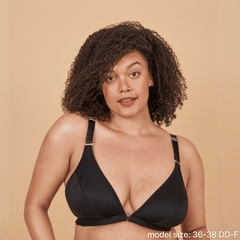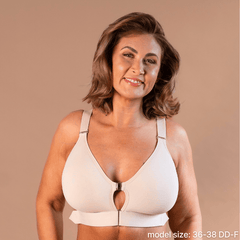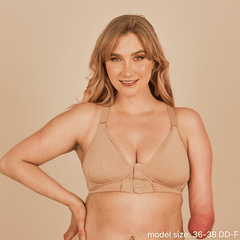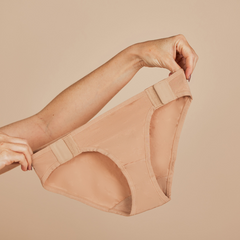
The CDC estimates that one in four adults in the United States live with some form of disability, and while their individual needs will look very different, one thing unites all people: we want to look stylish and show off our personality through clothing.
So, what makes clothing “adaptive”?
Adaptive apparel is clothing created particularly for persons with limited mobility who have trouble dressing themselves independently, or who have sensory difficulties with certain textures and materials. Limited mobility can come from a range of factors, such as older age, a physical or cognitive disability (long-term or recent), post-surgery soreness or equipment, or even a broken bone.
Adaptive clothing incorporates elements such as Velcro closures, one-handed zippers, wider necklines, adjustable pant hems, and magnetic buttons to make dressing simpler while maintaining a typical appearance on the outside. Other changes include the use of flat seams and the replacement of conventional tags with tagless alternatives to make clothes more comfortable on the skin.
Importantly, adaptive clothing can be for long-term or temporary mobility limitations. Many people are now choosing to shop for adaptive clothing after a surgery or broken limb, in order to maintain outward style despite temporary needs. After surgery, adults may need customizations in order to allow for medical ports, bandages, or slings. Post-surgery adaptive clothing often includes hidden flaps or zippers to allow for openings, loose soft fabric for comfort, and hidden pockets to store tubing or a battery pack.
Before clothing brands intentionally produced adaptive clothing, many individuals and families would need to find “hacks” to adjust their clothing using sewing tricks or safety pins. This option is not only inconvenient, but can lead to ill-fitting or drab outward style. Some individuals may default to clothes which are too big or slouchy, just to have flexibility or drawstrings to allow for flexibility. As more and more clothing allows for customizability and flexibility, persons with mobility issues can show off their individuality and independence without compromising on style.
Particularly in office settings, there is an unofficial “uniform” of professional work wear, and adaptive apparel can empower people to focus on their business without a doubt that clothing items will stay in place. In the United Kingdom in 2019, 3.9 million people who self-reported as having a disability worked in an office. Although traditional adaptive apparel pushes people toward active wear or loose sweats, people of all mobility levels go to work and deserve professional, stylish attire.
Inclusive clothing is not only positive socially—it’s just good business.
This is a huge untapped market of shoppers who want stylish, comfortable clothes modified to their needs, representing up to $400 billion (USD) in purchasing power globally by 2026.

Major brands are taking notice. Tommy Hilfiger, Kohl’s, American Eagle, and Target—to name a few—have collections featuring adult and children’s clothes for differing physical abilities. In 2017, Zappos announced their new adaptive wear category, selling hundreds of easy slide-on products and even allowing customers to buy just one shoe or a pair in differing sizes based on their needs.
In the past, major brands might have been able to dismiss the idea due to the high cost of creating new collections. The few clothes offered were shapeless, drab, and more akin to hospital attire than dinner attire. Brands can take note from the lessons of the plus-sized fashion industry, which represents $21 billion (USD) annually; meanwhile, Coresight Research estimates adaptive clothing sales could generate $64.3 billion per year in the U.S. in the future.
The increasing spotlight on inclusion in the fashion industry over the past decade is pushing major houses to create clothes with fashion and function.
What is adaptive lingerie?
The first frontier of adaptive clothing was outward style the world sees. Now, Springrose is continuing to push the boundaries of inclusion with adaptive undergarments.
All women deserve to feel comfortable and attractive in their bras, but traditional bras can be difficult or painful to put on, and adaptive ones can be ugly and size limited. Our adaptable bra designs encourage the wearer's independence in dressing and personal care, or can make a caregiver's job easier, with a bra specifically designed for upper mobility restrictions.
Adaptive lingerie applies the same philosophy of adaptive apparel to undergarments, making it all the more important for fabrics to be soft, straps to be adjustable, and dressing to be simple. Ideally, adaptive lingerie can be put on while laying down, sitting, or standing, making it ideal for wheelchair users or anyone with limited mobility.
Lingerie and undergarments are not simply clothes like any other, but are intimately tied to the wearer’s self-confidence, sensuality, womanhood, and feeling powerful. Springrose is proud to set new examples for how adaptive lingerie can fit every woman without compromising on beauty and style.




